How to Increase Your Blood Oxygen Levels: 21 Actionable Tips
Oxygen. It’s the lifeblood of our existence. It’s what helps our bodies function. It’s what helps us move and think, enabling us to achieve our daily goals, both big and small.
For our bodies to function, our cells need energy. Oxygen is the fuel that allows our cells to break down the glucose in our foods to create this energy. Blood vessels transport oxygen-rich red blood cells throughout our bodies, nourishing our tissues and allowing this process of energy production, or cellular respiration, to occur.
As we age, oxygen levels can wane. Blood vessels grow narrower, limiting the transportation of oxygen to red blood cells. This is one reason why we might feel physically and cognitively weaker.
If you’ve been wondering how to increase blood oxygen levels, you’re in luck. At DP World’s Aviv Clinics Dubai, we aim to defy limitations—getting older shouldn’t mean pressing the brake on your life. With the right resources and the benefits of more oxygen in your blood, you can take your foot off the brake and move forward confidently.

Understanding Blood Oxygen Levels
Your blood oxygen level (also referred to as blood oxygen saturation) is the amount of oxygen you have in your blood. Two main tests are available to measure your blood oxygen level—pulse oximetry and a blood draw test.
- A normal oxygen level using pulse oximetry (a small device often clipped onto your fingertip) is between 95% and 100%.
- For a blood draw, laboratories have different reference ranges and will have details regarding the normal oxygen range. Reach out to your lab or doctor if you have questions.
Low oxygen levels often indicate:
- Heart conditions
- Lung conditions, such as asthma and bronchitis
- Inflammation
- Sleep apnea
- A high-altitude environment
21 Quick and Actionable Tips on How to Increase Oxygen in Blood
Boosting oxygen levels involves these 21 actionable tips, organized by category.

Exercise Regularly
- Cardio: Cardio exercises increase your breathing rate, which helps you absorb more oxygen.
- Stretching: Stretching helps your muscles receive more blood, oxygen, and nutrients.
- Maintain a healthy weight: Excessive weight can strain the respiratory system and reduce lung capacity. Keeping a healthy weight can improve lung function and increase blood oxygen levels.
Maintain a Healthy Diet
What foods increase oxygen in the blood? To enrich your oxygen levels through a healthy diet, you should:
- Consume dark leafy greens: Leafy greens such as kale and spinach increase blood oxygen. They contain nitrogen, which “plays a major role in delivering oxygen throughout the body.”
- Incorporate iron-rich foods: Foods like white beans, tofu, and dark chocolate contain iron—an “essential element for blood production.”
- Snack on antioxidant-rich fruits: Fruits like blueberries and cranberries are high in antioxidants, which promote blood flow and provide more oxygen to tissues.

Maintain Good Posture
- Stand or sit up straight: Research notes “the best oxygenation [is] in the ‘sitting upright’ position.” Lying down for a long period can put pressure on your lungs. Take the time to stand or sit up straight to help increase lung capacity.
Keep Your Lungs Healthy
- Drink plenty of water: Well-hydrated lungs are more efficient at dispersing oxygen into your bloodstream. The average daily water intake for “men is about 15.5 cups and for women, about 11.5 cups.”
- Go outside: There’s nothing like a breath of fresh air to promote more oxygen flow. Not to mention, you’ll also get to take in the sunshine and some vitamin D!

Practice Deep Breathing Techniques
- Diaphragmatic breathing: Also called belly breathing, diaphragmatic breathing provides positive oxygenation effects.
- Sit up straight, one hand on your stomach, the other on your chest.
- Breathe slowly through the nostrils. In addition to your chest rising, you should also feel your stomach area expand with each full, diaphragmatic breath.
- Exhale slowly out your mouth.
- Repeat six or more times per minute for up to 15 minutes.
Minimize Exposure to Air Pollutants and Toxins
- Get indoor plants: House plants help remove organic chemicals in the indoor air.
- Set up an air purifier: An air purifier helps trap dust, pollen, and bacteria and disperses clean air back into your home.
- Choose electric over gas: For example, you may opt for an electric stove rather than a gas stove to avert indoor pollution.
- Quit smoking: Smoking has a detrimental effect on oxygen circulation. Make a plan to quit smoking and avoid second-hand smoke.

Improve Sleep Quality
- Stay consistent with your sleep schedule: Being well-rested is vital for maintaining healthy oxygen levels. Get up and go to bed at the same time each night. This consistency reinforces your body’s sleep-wake cycle.
- Limit naps: While sleeping during the day makes up for lost sleep, long naps might make it harder for you to fall asleep at night.
- Stay clear from caffeine: The general rule of thumb is to have a caffeine cut-off time of a “minimum of eight hours before bedtime.”
- Regulate bedroom temperature: An environment that is too hot or too cold is not conducive to good sleep. Keep your bedroom at a cool, but comfortable temperature.
Reduce Stress
- Connect with loved ones: When we feel stressed, our breathing becomes shallow. This inhibits healthy oxygen flow to the bloodstream. Reaching out to trusted friends and family members can help you feel supported and more grounded.
- Take on a hobby: A new hobby such as crocheting, baking, or writing can offer a healthy distraction and put your mind at ease.
- Seek therapy: Therapy offers a safe space to voice and process your concerns and discover healthy coping mechanisms.
The Power of Hyperbaric Oxygen Therapy (HBOT) in Increasing Blood Oxygen Level

All the above tips are good to implement on a day-to-day basis, but when you feel age-related decline coming on, additional measures might be needed.
Hyperbaric oxygen therapy (HBOT) is a significant way to help increase your blood oxygen levels. HBOT involves sitting in a pressurized chamber and breathing in 100% oxygen. Research has shown that breathing oxygen in a pressurized environment improves circulation and allows more oxygen to be absorbed into the bloodstream.
Aviv Clinics uses a unique, specialized HBOT protocol inside its state-of-the-art hyperbaric suites, which includes precise fluctuations of oxygen levels during each HBOT session.
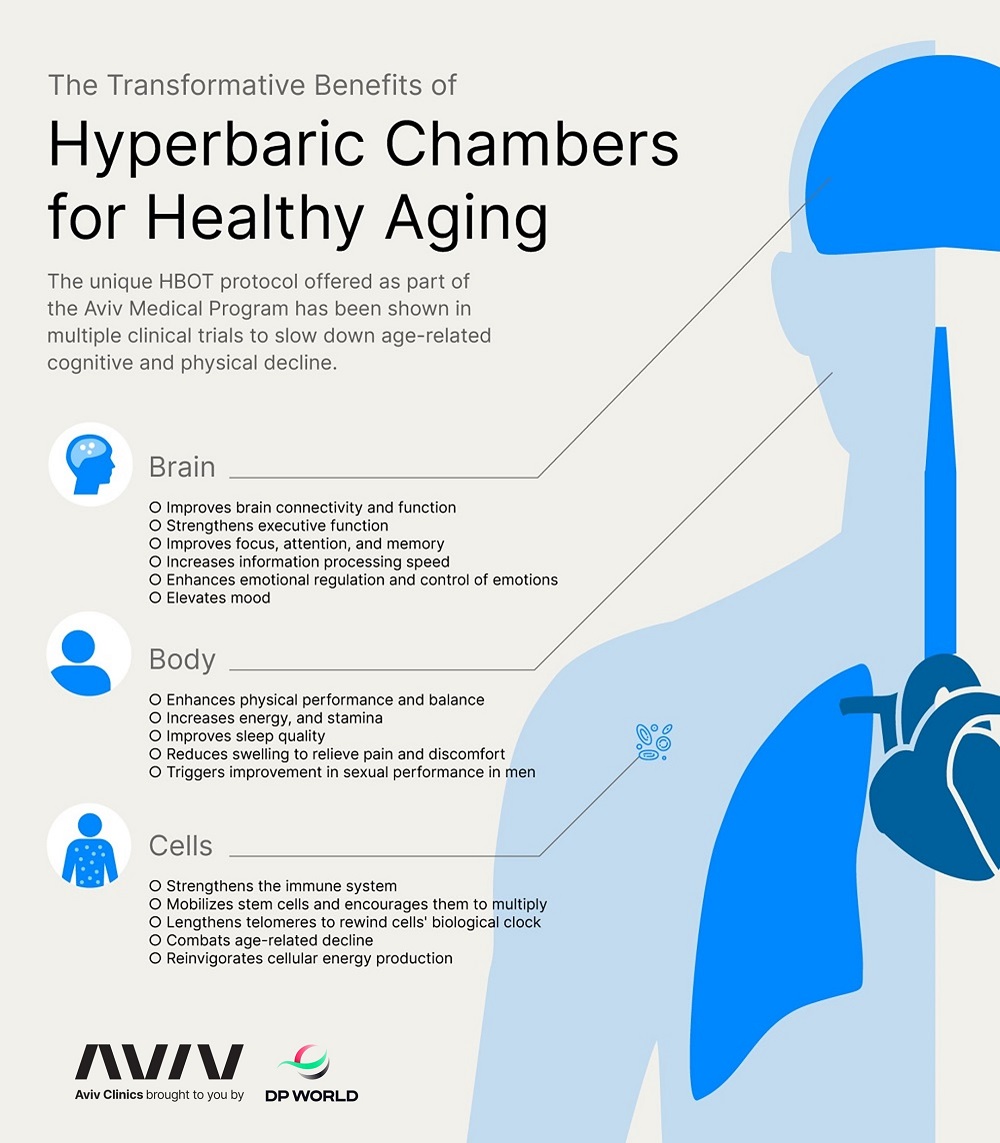
This specific HBOT protocol not only elevates levels of oxygen in the body, but also encourages your body to unlock its self-healing mechanisms.
Thanks to the biological progressions HBOT offers, the Aviv Clinic’s medical team has been able to help patients better manage conditions such as age-related concerns, traumatic brain injuries and stroke.

Take Charge of Your Health and Wellbeing
We encourage you to bookmark this page and practice these tips for increasing your blood oxygen levels and for making positive lifestyle changes.
Explore the Aviv Medical Program for more information on our evidence-based hyperbaric oxygen therapy protocol and comprehensive health assessment or contact us to learn how we can help you take charge of your health and wellbeing.
Your Health Is Your Wealth: The Importance of Investing in Your Health
The daily choices we make and the activities we engage in impact our quality of life. While health problems and expenses might be an expected norm with age, there are ways you can minimize or even avoid them altogether.
At Aviv Clinics Dubai, we believe making more conscious decisions today will give you the healthspan you deserve. Learn the importance of investing in your health and nine ways to get started.
Note: Speak to your doctor before you pursue any lifestyle changes.
1. Consider the MIND Diet
Eating healthy has been a consistent mantra over the years, and for good reason—there is a connection between diet and disease. A healthy diet is the foundation for feeling good.
While there are numerous diet trends out there, there is one truly worth your time and investment—the MIND diet.
The Mediterranean-DASH Intervention for Neurodegenerative Delay (MIND) diet is a blend of two highly effective diets:
- Mediterranean: Consists of a heart-healthy eating plan
- DASH: Aims to address hypertension or high blood pressure
Studies illustrate the MIND diet is “associated with reduced incidence of Alzheimer’s disease.”
Sticking to this diet that entails a variety of fruits and vegetables provides anti-inflammatory effects on the brain. This impact can strengthen brain cell structure and help regulate anxiety and mood.
2. Engage in Intermittent Fasting
We know—fasting doesn’t sound like the most exciting thing. But consider intermittent fasting. Not only can you achieve a healthy body composition, but you can also improve your brain health—all without strict dietary restrictions.
Intermittent fasting is a dietary lifestyle that comprises alternating periods of eating and fasting and limiting the number of hours you consume calories during the day/week.
This metabolic switching:
- “Promotes neuroplasticity and resistance of the brain to injury and disease”
- May “decrease the progression of Alzheimer’s disease in mice through changes to the gut microbiota”

3. Stay Educated on Fall Prevention Tactics
“Falls in older adults are a reasonably common occurrence.” Conditions that become prevalent as we age (e.g., muscle weakness, osteoporosis, and balance and gait problems) make us more susceptible to falls.
The key ingredient to prevention? Exercise. This entails:
- Strength training
- Cardio training
- Balance training
- Flexibility training
Other fall prevention tactics are just as important.
- Keep your home clear of clutter and trip hazards such as cords, books, shoes, etc.).
- Install grab bars in the bathroom and handrails in the hallways and stairways.
- Avoid wearing clothing that drags on the ground.
- Wear non-slip socks or shoes around the house.
- Take a pause after standing up and before beginning to walk.
4. Find Helpful Ways to Cope with Stress
Stress is inevitable, and the body and mind are biologically equipped to handle it. But sometimes, when the stress gets overwhelming, it can have adverse effects. ”Stress affects not only memory and many other brain functions, like mood and anxiety, but also promotes inflammation.”
Chronic stress can:
- Kill brain cells.
- Cause memory decline.
- Negatively impact mental health.
Whether you are grieving or dealing with a major change in your life, it’s essential to find healthy coping mechanisms for stress:
- Make time for physical activity: At Aviv Clinics, we recommend 30 minutes of exercise three days a week at a minimum. Exercise benefits the brain by releasing endorphins, helping relieve pain, and improving mood. The key is to find an activity you enjoy—this will make exercise fun and feel less like a chore.
- Be conscientious about screen time. Experts say, “The goal isn’t to eliminate screens from your life; it’s to imbue the time you spend on screens with ‘intentionality.’” When used wisely and with purpose, technology offers worthy benefits. But misusing it can cause more harm than good. Thus, stay aware and focus on balancing screen time with other activities.
- Meditate. Not only is meditation a great activity to do instead of “doom scrolling” on your screen, but meditation may promote several benefits such as “reduction of cognitive decline” and “increase in quality of life.”

5. Focus on Body Composition Instead of Weight
A low number on the bathroom scale doesn’t necessarily mean all is well. Indeed, society’s obsession with the scale can lead to problems like declining muscle mass—a condition that will do more harm than good later in life.
So toss that unhealthy relationship with the bathroom scale. Instead, look at your overall body composition.
For example, Aviv Clinics uses the seca scale to get a precise rundown of the meaning behind a person’s weight. This scale helps us develop an accurate and customized treatment plan—losing body fat, gaining muscle, or a combination of both.
Speak to your doctor to gain a comprehensive assessment of your body composition so you can make appropriate, personalized goals.
6. Stick to a Consistent Sleep Schedule
Since the sleep hormone melatonin naturally decreases with age, it’s vital to set up healthy sleeping habits. This entails turning off all electronics an hour before bedtime and getting in bed at the same time each night. Doing so will promote natural circadian rhythms and maintain cognitive health.

7. Engage in Games
Investing in your health doesn’t have to be boring—it can include games!
That’s right, playing brain games is a fun and active way to train your brain. Researchers report “the effectiveness of cognitive intervention in maintaining cognitive health over the long-term.”
The brain functions similarly to muscles building muscle fibers after exercise—it promotes new neurons and neuronal connections after participating in games.
8. Listen to More Music
When was the last time you truly listened to music? What kinds of images and memories did it elicit?
Music offers far more advantages than helping you get through a grueling drive or setting the tone for a party. The best part is these benefits are backed by research.
Studies illustrate music can:
- Improve “cognitive function in people living with dementia, as well as quality of life after the intervention and long-term depression.”
- Reduce “measures of anxiety in a population of residential care patients with dementia.”
- Provide “better sleep quality” for “adults who listened to 45 minutes of music before going to sleep.

9. Find a Research-Backed HBOT Program
Hyperbaric oxygen therapy (HBOT) is a treatment in which the patient breathes 100% pure oxygen in a pressurized chamber. Aviv’s luxury, state-of-the art hyperbaric oxygen therapy suites are the largest and most advance in Dubai and the surrounding region.
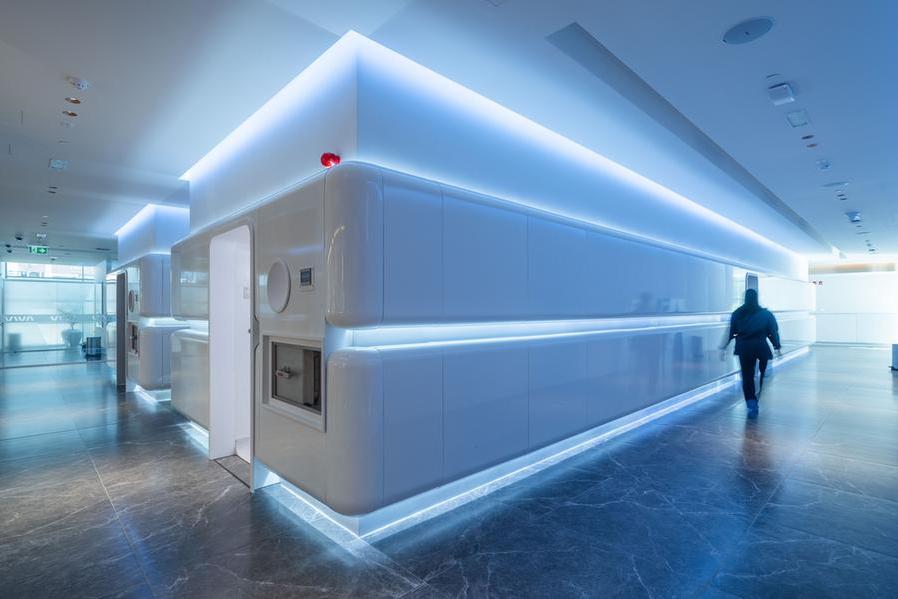
Several studies illustrate the potential of HBOT in improving cognitive, physical, and psychological performance when administered in a specific protocol. Aviv Clinic’s HBOT protocol fluctuates oxygen levels during each hyperbaric session. This system increases oxygen levels in the body up to 20 times higher than normal and boosts your brain’s ability to heal.
The unique medical program at Aviv Clinics consists of a treatment program that include this same research-backed HBOT protocol along with cognitive training, dietary coaching, and physical performance training in a physician-designed program tailored to each client’s needs.
This holistic approach gives each patient the personalized care they deserve for their unique health conditions. Our clients have optimized their athletic performance with HBOT and have found relief from debilitating medical conditions such as stroke and traumatic brain injury.
Couple Pursues Healthy Aging & Cognitive Decline Prevention | Bob & Laurie’s Story
Invest in Your Health at DP World’s Aviv Clinics Dubai
The Aviv Medical Program stands by a holistic treatment program that targets all areas discussed above. A series of independent clinical trials illustrate how our program helps treat the symptoms of different health conditions.
Rehabilitation Options, Including Hyperbaric Oxygen Therapy (HBOT), for Stroke Patients
Strokes are “a leading cause of serious long-term disability” in the United States. Given that “87% of all strokes are ischemic” or caused by artery or vein blockage, it makes sense that most patients suffer long-term functional impairments.
These impairments can range from paralysis, speech difficulties, and sensory issues to a host of other cognitive dysfunctions. Additionally, many stroke patients have had a stroke before—“nearly 1 in 4” survivors have suffered at least one stroke previously.
Rest assured, multiple rehabilitation options are available for stroke patients, including hyperbaric oxygen therapy (HBOT). We dive into the key details below.
Remember that each person’s medical condition and background are entirely unique. Thus, speaking with a physician about treatment options is essential to getting back to optimal health.

What Are the 3 Common Stroke Relief Options?
Stroke relief generally entails working with a diverse medical team of physicians, nurses, and therapists. This support team may recommend one or more of the following options:
- Speech therapy: Stroke patients can experience speech challenges, ranging from slurred world to significant difficulties with oral communication or understanding people (aphasia). This is due to damage to the “left side of the brain that controls speech and language.” Cases like this often merit speech therapy.
Patients work with speech-language pathologists (SLPs) to relearn techniques such as:
- Controlling mouth and throat muscles to speak more clearly and adequately swallow
- Participating in cognitive language exercises to restore communication and comprehension skills
Research illustrates early speech intervention with aphasia patients “had a massive increase in their ability to communicate at 12 and 26 weeks after their stroke.” Patients could speak better and exhibited less difficulty finding and using the right words.
- Physical therapy: A physical therapist (PT) engages patients in movement exercises to help them reacquire motor skills. PTs generally help stroke patients relearn activities such as walking, sitting, standing, and switching from one movement to another.
Medical experts believe consistent PT lowers “risks of hospital readmission within a month after discharge” because it helps patients:
- Restore movement and accomplish tasks
- Plan for the next step of post-acute care (e.g., patient rehab facility, skilled nursing facility, or home care assistance)
- Occupational therapy: Occupational therapists help patients carry out everyday activities. They aim to help stroke patients live as independently as they can. OTs work with post-stroke patients to assess how the stroke has affected their lifestyle.
For those who have difficulties dressing, cooking, or bathing, the OT will find solutions to help carry out these activities of daily living to the best of their ability. These statistics outline the importance of OT in the recovery process.
- One study of Medicare claims data found that “Rehabilitation services including physical therapy and occupational therapy play important roles in promoting functional recovery and preventing deconditioning during acute hospitalizations.” However, “Only 61% of patients with ischemic stroke received both physical therapy and occupational therapy services in the acute setting.”
One study notes that patients who participated in OT programs focused on impairment and basic living activities “progressed to more advanced activities over time (e.g., less bed mobility, more home management).”

The Groundbreaking Therapeutic Approach of HBOT
An up-and-coming therapy for long-term stroke recovery that has shown promise in clinical research is Hyperbaric Oxygen Therapy (HBOT). HBOT has clear indications of brain-cell rehabilitation in patients suffering from post-stroke disabilities.
HBOT and its apparent benefits for post-stroke patients were studied and reviewed in an article published in the peer-reviewed journal PLOS One:
- The participants were exposed to a unique protocol, including daily HBOT sessions over two months. All the patients showed improved neurological functioning, indicating “that HBOT can lead to significant neurological improvements in post stroke patients even at chronic late stages.”
- Noticeable recovery included “regained speech (almost fluent) and reading capabilities.” Even in patients with less dramatic results, everyday tasks like bathing and dressing became possible unaided by the end of the treatment period.
- Patients were further assessed using brain metabolism imaging (SPECT scans) to examine brain activity during the HBOT treatment. “The SPECT after HBOT demonstrated the disappearance of the perfusion lesions.”
- The study indicated a link between oxygen and stroke—“increasing the plasma oxygen concentration with hyperbaric oxygenation is a potent means of delivering to the brain sufficient oxygen for tissue repair.”
Not only did the study determine significant improvements in patients treated with HBOT, it crucially found that the progression occurred in patients even many months after the stroke event.
The study’s objective was to “evaluate the effects of HBOT started in the late-chronic phase after the acute stroke.” All the patients experienced strokes between six and 36 months prior to the HBOT treatment.
The Aviv Medical Program: The Road to a Better Life
Backed by over a decade of research, the Aviv Medical Program can include HBOT, along with cognitive training, dietary coaching, and physical performance training to help you recover even long after a stroke.
The program aims to offer patients a customized, coordinated, and multidisciplinary health plan to address their specific goals. As the aging process affects every person differently, each Aviv Clinics plan is individualized based on a patient’s post-stroke recovery needs.
Here’s how our process works:
- Assessment: Our dedicated team will conduct a thorough assessment to gain a holistic understanding of your health and craft a personalized health plan.
- Treatment: Under the supervision of Aviv’s medical staff, the treatment plan will entail a variety of health programs that are meant to get you on the road to recovery.
- Analysis: We will track data on how your treatment plan is progressing and make the necessary adjustments along the way.
- Follow-up: Upon conclusion of the treatment, our team will continue to follow up on your progress via an Aviv wearable device. This will allow us to send you reports on your health and performance.
Keren’s Inspiring Story
A holistic treatment plan that addresses the mind and body is key to successful recovery. Former Aviv Clinics patient Keren Trabelsi is a true testament to this fact.
Businesswoman and mother Keren Trabelsi suffered an ischemic stroke, causing paralysis on the left side of her body. Also, cognitive issues made daily tasks difficult, which did not make her feel as capable as she had been before. She sought the help of Aviv Clinics.
Now, 13 months later, she can walk comfortably, type with her left hand again, and engage in cognitive activities (i.e., crossword puzzles, Sudoku, etc.).
“[ Aviv Clinics is] like driving a Ferrari on the road to recovery versus driving like an old beaten-up car….”
Watch her post-stroke recovery story.
Stay current on our client success stories to learn more about what the Aviv Medical Program can help you achieve.
Is the Aviv Medical Program Right for You?
If you’ve been experiencing cognitive or physical challenges since your stroke, the Aviv Medical Program may be able to help. We have treated thousands of patients suffering from various conditions, enhancing their quality of life.
We encourage you to speak with one of our licensed medical staff to see if it’s right for you, as each person’s body, medical history, and circumstances differ. Our staff will take the time to understand your health history, symptoms, and goals. This process will help us determine whether the Aviv protocol is a good fit.
How Long Does It Take to See Results?
Improving physical and cognitive performance does not happen overnight. The Aviv Medical Program requires time and careful compliance to achieve success.
HBOT sessions take approximately two hours daily, five days a week, for 8-12 weeks. However, this timeline may vary across patients. Our clients see members of the Aviv healthcare team for additional therapies or coaching (e.g., cognitive training, dietary coaching, and physical performance training) multiple times each week.
Learn More about Post-Stroke Recovery
If you need help finding a stroke recovery plan, contact Aviv Clinics. Our diverse team of medical professionals is experienced in crafting customized treatment plans that have brought significant and fulfilling results for our patients.
Improving your quality of life begins here.
Anti-Aging Effects of Hyperbaric Oxygen Therapy (HBOT) Shown to Reverse Aging Biomarkers in Humans
A landmark study in Israel has found that hyperbaric oxygen therapy (HBOT) can reverse two key biological signs of aging in humans—the first study to ever make this finding.
Published in the peer-reviewed journal Aging, the study shows that it is possible to target and reverse the aging process at the basic cellular-biological level.
This breakthrough in the biology of aging provides scientists with a new foundation for investigating ways to slow the aging process. Learn more about the empirically validated anti-aging effects HBOT can have.
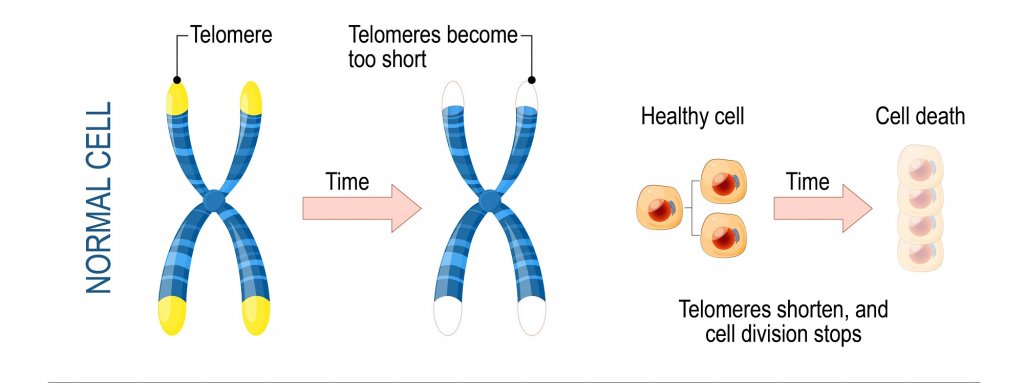
The 2 Key Biological Signs of Aging
Two common signs of biological aging are:
- Shortening of telomeres on our chromosomes: Telomeres are like the hardened ends of shoelaces. They protect the ends of chromosomes from deterioration. As we age, our telomeres naturally shorten, but a yearly decrease of their length by 20–40 bases is associated with serious illnesses.
- Accumulation of senescent cells: Senescent cells are cells that are still alive, but have stopped multiplying. Over time, these cells can accumulate in the body and their increase contributes to age-associated conditions.
In the groundbreaking study, patients aged 64 and older underwent a series of unique HBOT anti-aging programs. Multiple blood tests conducted during the study showed “HBOT may induce significant senolytic effects including significantly increasing telomere length and clearance of senescent cells in the aging populations.”
The “Holy Grail” of the Biology of Aging
A different study released in 2020 showed that HBOT also improves cognitive functions of memory and processing speed, among other areas.
The studies have been conducted over a decade of research and caused Dr. Shai Efrati—the study’s co-author—to develop a unique medical program available at Aviv Clinics.
According to Efrati, director of the Sagol Center for Hyperbaric Medicine and Research at the Shamir Medical Center in Israel:
“After dedicating our HBOT research to exploring its impact on the areas of brain functionality and age-related cognitive decline, we have now uncovered for the first time in humans HBOT’s biological effects at the cellular level in healthy aging adults.”
Efrati called telomere shortening “the ‘Holy Grail’ of the biology of aging” and developed the Aviv Medical Program based upon the results testing, study, and research.
“The significant improvement of telomere length shown during and after these unique HBOT protocols provides the scientific community with a new foundation of understanding that aging can, indeed, be targeted and reversed at the basic cellular-biological level.”
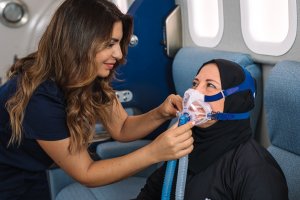

Study Findings on Anti-Aging Effects of HBOT
- “Telomeres length of T helper, T cytotoxic, natural killer and B cells increased significantly by over 20% following HBOT”
- “There was a significant decrease in the number of senescent T helpers by -37.30%±33.04 post-HBOT.”
According to Dr. Amir Hadanny (co-author of the study) the pioneering study has:
“Opened the door for further research on the prolonged cellular impact of HBOT to reverse the aging process. In just three months of HBOT, we were able to achieve such significant telomere elongation—at rates far beyond any of the currently available interventions or lifestyle modifications.”
There is also the potential for HBOT to be used as an anti-aging mechanism for skin care. HBOT may serve as “an important component in skin rejuvenation, treatment of photoaging skin, and improvement in skin complexions.”
Notable Individuals Who Have Pursued HBOT
Due to the impressive data-backed results, many notable individuals have decided to pursue HBOT themselves:
- Michael Phelps: 28-time Olympic medalist used hyperbaric oxygen therapy to help with his recovery from training. The high-altitude conditions and boosted levels of oxygen have aided in helping Phelps bounce back from his workouts and continue to win medals throughout his 24-year career.
- Justin Bieber: Having been diagnosed with Lyme Disease and dealt with drug abuse, the pop star regularly uses hyperbaric oxygen therapy. Bieber, who also mentioned he struggles with anxiety and depression, notes that HBOT helps alleviate his stress levels.
- Alon Day: The demands of professional racing are high, with reaction times measured in fractions of a second. Watch three-time NASCAR Whelen Euro Series champ Alon Day explain how the treatments offered by the Aviv Medical Program ensure he meets the sport’s high demands — both mental and physical.
- Watch video here
The Aviv Medical Program: What We Offer
The unique HBOT protocol from the extensive research outlined earlier is available in the United States only at Aviv Clinics. The Aviv Medical Program may include a combination of:
- In-depth review of health history
- Comprehensive physical exam
- Highly advanced brain imaging scans
- Neurological and neurocognitive tests
- Body composition analysis
- A detailed report of our assessment findings
- Cognitive training
- Physical training
- Dietary coaching
- Hyperbaric oxygen therapy (HBOT)
- A post-program report of your improvements and recommendations for future progress
Each patient undergoes extensive assessments and evaluations before, during, and after their HBOT sessions to monitor and analyze progress.
Here’s What Our Clients Have to Say
Aviv Clinic’s clients are a testament to the benefits our program offers. We’ll let these reviews speak for themselves:
- “I can’t thank the team at Aviv enough for helping me feel better than I have in over twenty years. I have more energy, more focus and live a healthier and more fulfilling life. Your support and encouragement has made a total difference in my life. Thank you for all you do.”
—Barbara Christoph
- “My wife and I took the program together and had an amazing experience. Both of us are healthier and happier than before and are continuing on with what the program showed us. An amazing staff led by leading edge doctors who are second to none. I recommend this program to anyone suffering from the ailments of aging and loss of cognition.”
—Andy Smith
- “My goal for attending the Avivprogram was healthy aging. I also wanted to manage stress better, address chronic back issues, gain weight and improve cognitively…I have experienced several unanticipated and unintentional benefits of the Aviv program: I have reduced my alcohol consumption. Never having been one to turn down a glass (or two) of wine, I just don’t have the desire to drink as much; My skin seems smoother and more supple. I am told I look younger and that is always nice to hear; I have made incredible friendships through the Aviv program and met some celebrity athletes and renowned physicians. I am particularly grateful to an orthopedic surgeon I met who was also participating in the Aviv program that helped me focus my attention on managing my osteoporosis.”
—Zizi MacKinnon
More information about Aviv Clinics Dubai, click here.
The clinic offers free phone consultations for interested individuals.
Contact the clinic to learn more about the unique program.
Meditation and Brain Health: Benefits Backed by Science
The COVID-19 virus has left us all more stressed than ever before, but there’s one group of people that the pandemic has hit especially hard: older adults. A recent poll conducted by the National Poll on Healthy Aging interviewed 2,000 adults from the ages of 50 to 80. More than half (56%) of the participants reported struggling with feelings of isolation during the pandemic, a dramatic increase from 27% in the 2018 poll.
Long hours spent indoors away from family and friends can have us all feeling low, and the stress and loneliness can wreak havoc on your mental health. That’s why many older adults are turning to the practice of mindfulness meditation to cope with stressful feelings during the pandemic.
Just like washing your hands to get rid of germs, meditation is an excellent way to help cleanse your mind of troublesome thoughts, and practicing mindfulness can do more than just help you relax. Taking a few minutes out of your day to ground yourself in the present moment is one of the most rewarding things you can do for your mental health, and the benefits are backed by science.
The science-based Aviv Medical Program is centered on the innovative hyperbaric oxygen therapy, cognitive and physical training, plus nutrition coaching. Supportive wellness practices, such as meditation, help to create a truly holistic approach to enhancing cognitive and physical performance.

What is meditation? The art of mindfulness
Mindfulness meditation is the art of being present in the here and now.
It’s about taking a few minutes every day to clear your mind of distressing thoughts and engaging with what’s right in front of you.
Think of it as a workout for your brain. In the same way that you might lift weights to keep your body strong, meditation is a way to train your mind and increase your focus and awareness. It’s not a spiritual practice or a mystical art; it’s a learned skill and anyone can learn to meditate, regardless of age.
5 Benefits of meditation backed by science
There are several proven benefits to meditating regularly. Numerous studies have shown that mindfulness practices like meditation and yoga can improve all sorts of mental health problems. From easing anxiety and depression to stalling memory loss in Alzheimer’s patients, here are our top 5 benefits of meditation.
1. Slows the progression of Alzheimer’s disease
Although many people dismiss lapses in memory recall as a side effect of growing older, there’s no scientific evidence to suggest memory loss is a natural side-effect of aging. On the contrary, forgetting valuable memories doesn’t have to be the new normal for older adults.
Meditation has been proven to improve memory recall in adults in as little as eight weeks. Research also shows promising results in the use of mindfulness to slow the progression of cognitive conditions like Alzheimer’s disease and dementia. Patients who practiced mindfulness exercises reported reductions in cognitive decline and stress levels, and overall improvements to their quality of life.
Mindfulness isn’t only beneficial for those diagnosed with cognitive conditions, either. Studies have also shown that caregivers of those with cognitive impairments can benefit from the stress reduction of practicing meditation. In other words, everyone can benefit from the boost to cognitive centers of the brain.
2. Improves focus and keeps your brain sharp
Practicing mindfulness can keep your brain active and in good shape, no matter how good your memory is. You don’t have to be a seasoned expert. Even beginners can reap the benefits of mindfulness meditation.
In one study, participants who listened to a 10-minute meditation tape experienced increased attention spans and focus when completing a test compared to those who didn’t meditate beforehand. One researcher further confirmed that people who meditate regularly consistently perform better on focus-related tasks. The same study also found that meditation calms the areas of the brain associated with mind-wandering and spontaneous thoughts, helping you stay focused on what you are doing in the present.
3. Combats insomnia
Getting a good night’s rest is more important than ever for seniors and older adults. Sleep is the vital period when our minds cleanse themselves of harmful waste. Yet current research estimates 10-30% of people are affected by chronic insomnia, with older adults showing more susceptibility to sleep disturbances.
A randomized trial found that mindfulness meditation significantly improved sleep quality in middle-aged and older adults. The lowered stress levels provided by meditation helps clear your mind from troubling thoughts, which can make sleep come easier. If you have trouble sleeping at night, turn off your screens and try meditating for a few minutes before bed.
4. Fights anxiety
Although everyone worries from time to time, harboring too much stress in your body can be unhealthy. According to researchers, anywhere from 3-14% of all older adults meet the diagnostic criteria for generalized anxiety disorder. Unchecked anxiety and stress can worsen health conditions like fibromyalgia and lead to other mental health problems like depression.
If you want to take control of your anxious thoughts, meditation may be the solution. Studies have shown that mindfulness meditation can alleviate symptoms of generalized anxiety disorder and reduce stress levels, helping you clear your mind of fears and worries.
5. Improves depression and overall mood
Loneliness was already a common problem among older adults and retirees, but the COVID-19 pandemic has made it worse. Going out in public and visiting your family isn’t an option for many older adults, and the isolation can worsen feelings of loneliness and despair
Practicing mindfulness can help you manage these difficult emotions and improve your overall mood. Studies have shown that mindfulness training reduces feelings of loneliness and isolation, helping participants be happier in the present moment.
Mindfulness training has been shown to help reduce feelings of depression in adults. Those who practiced meditation therapy reported fewer symptoms of depression compared to their counterparts who didn’t meditate at all. Practicing mindfulness every day reminds you not to stress over every little thing, helping you stay calmer and more in control of your emotions.
How to start a mindfulness meditation practice
You don’t need any special equipment or training to get started. All you need is a comfortable place to sit and the willingness to give it a try. Here’s a quick guide to get you started:
1. Find a quiet space where you can relax, free from distractions.
If you’re inside, make sure that all televisions and electronic devices are turned off.
2. Sit in a comfortable position and breathe gently.
3. Pay attention to each inhale and exhale.
4. Focus on all the sensations of your body as you breathe.
5. Release any tensions you may be holding until you are completely relaxed.
6. Continue to breathe in and out as you focus on your body’s inner sensations.
7. If your mind wanders, that’s ok. Just re-focus on your breathing and start again.
8. Keep going for 5-10 minutes or as long as you’d like to meditate.
Try to meditate at the same time every day to establish a routine. If you don’t want to sit in silence, you can find guided sessions via apps on your smart devices, or you can play some calming music to help you focus. For added benefits, try meditating outside on the porch or in a garden. Doing your daily session in nature can calm you even further, helping you make the most of your mindfulness practice.
The bottom line
Mindfulness meditation is one of the most positive things you can do for your mental health and emotional well-being. It doesn’t take long to do, either. Having a simple routine to keep your mind in-shape can show benefits across all areas of your life. From improving memory recall to lowering stress levels and improving your sleep, practicing meditation can keep you more engaged in the present moment, helping you stay happy and calm during the best years of your life.
Aviv Clinics delivers a highly effective, science-based treatment protocol to enhance brain performance and improve symptoms of conditions such as traumatic brain injuries, fibromyalgia, Lyme, and dementia. The Aviv Medical Program’s intensive treatment protocol uses hyperbaric oxygen therapy and takes a holistic approach that includes brain training to achieve optimal results. Based on over a decade of research and development, the Aviv Medical Program is customized to your needs.
Encouraging results in healing anoxic brain damage with Hyperbaric Oxygen Treatment
According to the CDC, “roughly 805,0000 Americans in the United States have a heart attack each year.” The resultant damage to the heart is well understood, but a cardiac arrest can have equal impact on the brain.
Researchers found “cognitive impairments after OHCA [out-of-hospital cardiac arrest] are common and affect up to 50% [of patients].” These impairments involve “executive functions, memory, and processing speed.”
Oxygen deprivation during the heart attack can lead to an anoxic brain injury. The effects of oxygen deprivation include diminished visual perception, cognition, expression, and more.
Fortunately, there is researched-based evidence that offers hope for anoxic brain injury treatment. And Aviv Clinics at The VillagesⓇ may have the resources and tools to unlock this potential. Keep reading to learn more.
What Is Anoxic Brain Injury?
Anoxic brain injury occurs when there is a complete lack of oxygen to the brain. After about four minutes of oxygen deprivation, brain cells begin to die.
Here’s why and how:
- Blood carries oxygen to the brain
- Malignant conditions (such as a blood clot, stroke, or heart attack) cause the blood flow to slow or get blocked.
- Other circumstances like high altitude (where oxygen is lacking) and exposure to toxic substances (e.g., carbon monoxide) can also lead to restrictions in blood flow.
What Are Symptoms of Anoxic Brain Damage?
Symptom of anoxic brain injury may include:
- Headaches
- Difficulties with thinking, focusing, and memory
- Mood swings
- Loss of consciousness
- Changes in sleeping patterns
- Seizures
- Vision problems
Use of HBOT in Improving Brain Function
Hyperbaric oxygen therapy (HBOT) is a novel therapy that increases oxygen levels in the body up to 20 times higher than normal. This effect increases the amount of oxygen in the blood, providing the energy the brain and body need to revive self-healing mechanisms.
What Research Says
A study from the Restorative Neurology and Neuroscience reports HBOT “can induce neuroplasticity and improve cognitive functions of patients suffering from anoxic brain damage.” This is valid many months—and sometimes years—after the cardiac event.
Research Method
The study assessed:
- 11 cases of patients with chronic cognitive impairments (CCI) from cardiac arrest
- Patients’ neurocognitive abilities prior to HBOT treatment
- The overall functionality of patients’ daily activities
- Patients’ general well-being
- Scans of affected areas, using new brain metabolism imaging equipment
All of these observations were carried out again, following treatment with HBOT. Patients were given “60 daily sessions” of HBOT—all of which were conducted “0.5–7.5 years after the cardiac arrest.”
Research Conclusion
Notwithstanding the lengthy period following the cardiac event, HBOT treatment showed to have a substantial impact on the patients’ cognitive abilities:
- Clinical changes were assessed through neurocognitive assessments. These tests showed a distinct correlation between the recorded results and improvements in the quality of life and ability to undertake daily activities.
- HBOT “was found to induce modest, but statistically significant improvement in memory, attention and executive function.”
- According to the authors of the study, HBOT is able to “reactivate neuronal activity by increasing plasma dissolved oxygen”. This approach delivers oxygen to the brain in a highly efficient manner.
- Thus, it is very probable HBOT will be a candidate for enhanced therapy for anoxic brain injury patients with the appropriate profile.
Hyperbaric Oxygen Treatment for Brain Injuries
In addition to anoxic brain damage, there are other types of brain injuries—several of which may benefit from hyperbaric oxygen therapy.
For example:
- One study reports “in children with traumatic brain injury (TBI), the addition of HBOT significantly improved outcome and quality of life and reduced the risk of complications.” As it is definitely possible to have a TBI and not know it, further research notes HBOT can “improve post concussion syndrome years after mild traumatic brain injury.”
- Another research study conducted HBOT on post-stroke patients in the chronic stage between 2008–2018. Results concluded that:
- “HBOT induces significant improvements in all cognitive domains even in the late chronic stage.”
- “HBOT induced a significant increase in all the cognitive function domains (p < 0.05), with 86% of the stroke victims achieving CSI [clinically significant improvements].”
- In a study that conducted HBOT on 73 long-COVID patients with “persisting physical, neurocognitive, and neuropsychological symptoms,” clinical outcomes illustrated “significant improvement in brain MRI perfusion and microstructural changes in the supramarginal gyrus, left supplementary motor area, right insula, left frontal precentral gyrus, right middle frontal gyrus, and superior corona radiata.”
Get Back to Optimal Performance with Aviv Clinics
A unique protocol based on Hyperbaric Oxygen Treatment was clearly shown to help heal anoxic brain damage. This protocol is available at the Aviv Clinic at the Center for Advanced Healthcare at Brownwood, The Villages, Florida.
For more information, or to schedule a consultation, contact the clinic.
This protocol is available at the Aviv Clinics, JLT, Dubai U.A.E.
For more information, or to schedule a consultation, contact the clinic.
Breakthrough Study Show Hyperbaric Oxygen Treatments Helps Stop Biological Aging
A landmark study from researchers in Israel has found that hyperbaric oxygen therapy (HBOT) improves two key biological signs of aging in humans – the first study to ever make this finding. The research shows it’s possible to target the aging process at the basic cellular-biological level. This breakthrough in biology of aging research provides scientists a new foundation for investigating ways to slow the aging process.
Published in the peer-reviewed journal Aging, the study involved patients aged 64 and older who went through a series of HBOT treatments. Blood tests taken over the course of the study showed hyperbaric oxygen treatment improved two common signs of biological aging – a shortening of telomeres on chromosomes and the accumulation of senescent cells.
The significance of this is difficult to overstate. Telomeres are nucleotide sequences that protect the ends of chromosomes from deterioration or fusion with other chromosomes. A shortening in their length of about 20 to 40 bases per year is associated with serious life-threatening illnesses. Stopping and reversing telomere shortening has long been considered a key to slowing biological aging.
Senescent cells inhibit cell proliferation. The accumulation of senescence cells contributes to age-associated conditions and illnesses. Eliminating them can improve those conditions and illnesses, according to past animal studies.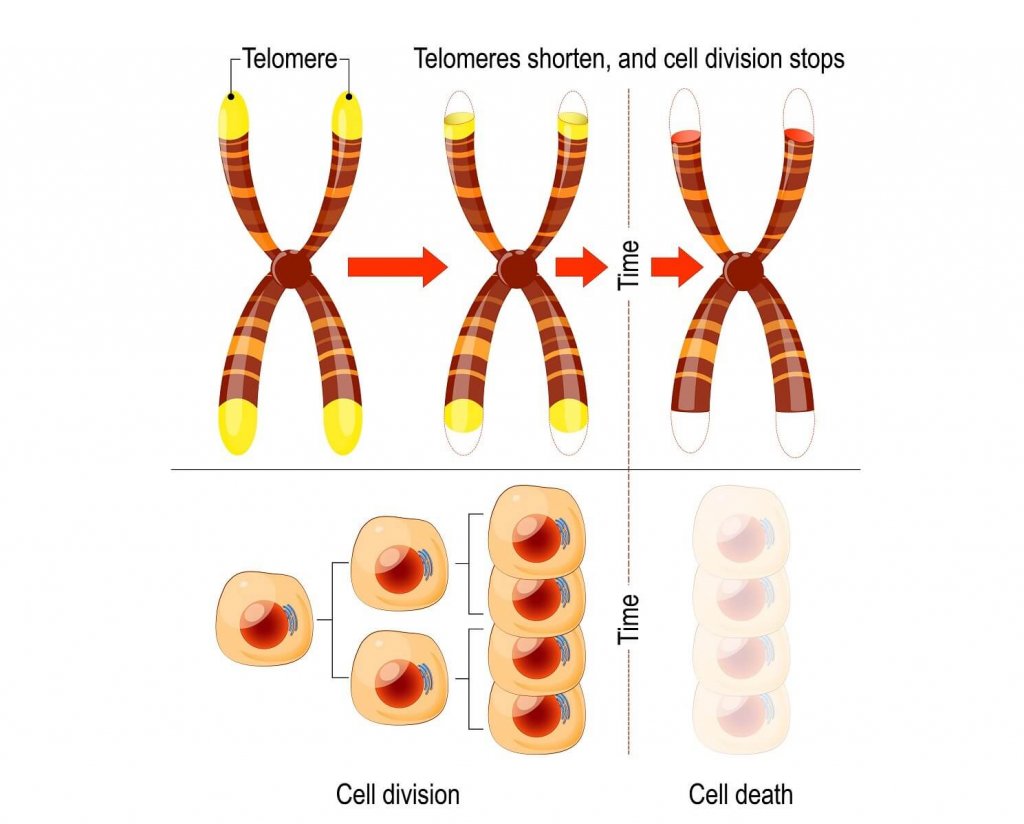
The “Holy Grail” of the Biology of Aging
The new study is part of an ongoing comprehensive aging research program in Israel. A previous study, released earlier in 2020, showed that HBOT also improves cognitive function.
“After dedicating our HBOT research to exploring its impact on the areas of brain functionality and age-related cognitive decline, we have now uncovered for the first time in humans HBOT’s biological effects at the cellular level in healthy aging adults,” Dr. Shai Efrati, director of the Sagol Center for Hyperbaric Medicine and Research at the Yitzhak Shamir Medical Center and a co-author on the study, said in a news release.
Efrati called telomere shortening “the ‘Holy Grail’ of the biology of aging” and noted that researchers are exploring many pharmacological and environmental interventions in the hope of enabling telomere elongation.
“The significant improvement of telomere length shown during and after these unique HBOT protocols provides the scientific community with a new foundation of understanding that aging can, indeed, be targeted and reversed at the basic cellular-biological level,” said Efrati, who also holds an associate professor position at the Sackler Faculty of Medicine and the Sagol School of Neuroscience at Tel Aviv University.
How The Study Was Conducted
Efrati co-authored the study with Dr. Amir Hadanny, Chief Medical Research Officer of The Sagol Center for Hyperbaric Medicine and Research. The two focused on testing the impact of HBOT on telomere length and senescent cell concentrations in a non-pathological, aging adult population.
Efrati and Hadanny conducted the prospective trial with 35 healthy, independent adults. None of the patients made any changes to their lifestyle, diet or medication during the study. Each received 60 daily HBOT sessions over the course of 90 days.
Whole blood samples were collected before treatment and again at the 30th and 60th session. Their blood was checked again one to two weeks following the last HBOT session to assess peripheral blood mononuclear cells (PMBCs) telomere length and senescence.
The study found that certain HBOT protocols induced regenerative effects.
Some telomeres increased by more than 20% in length, while senescent cells decreased in number by as much as 37%.
Dr. Hadanny said the pioneering study has
“opened the door for further research on the prolonged cellular impact of HBOT to reverse the aging process.”
He said that up until the study, only lifestyle modifications and intense exercise showed the ability to slow telomere length shortening.
“What is remarkable to note in our study is that in just three months of HBOT, we were able to achieve such significant telomere elongation – at rates far beyond any of the current available interventions or lifestyle modifications,” said Dr. Hadanny.

Dr. Efrati is medical advisor to Aviv Scientific LTD, which offers HBOT treatments, cognitive and physical training and nutritional coaching to enhance brain and body performance at the at the Aviv Clinics, JLT, Dubai U.A.E.
For more information, or to schedule a consultation, contact the clinic.